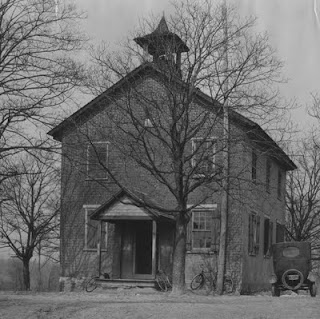 |
| Fairview School, 1925 |
The particular school we'll look at in this post was known as the Fairview School, or District #90 School. It was located on the northwest corner of Polly Drummond Hill Road and Smith Mill Road, not far south of Ebenezer Methodist Church. OK, "was located" is not entirely accurate, since the school building is still there. (I have gone back and corrected the Mt. Pleasant and Union Schools post where I stated that Harmony was the only remaining school.) However, the building was heavily altered after being closed as a school, among other things making it ineligible for inclusion on the National Register of Historic Places.
The two-story, brick schoolhouse was built in 1867 to service what was likely a newly carved-out district, District #90. The school is shown on the 1868 Beers map, but (obviously) is absent from the earlier 1849 Rea & Price map. For that matter, Smith Mill Road is not even on the 1849 map. This is just conjecture on my part, but I have a feeling that the creation of this district and school had something, either directly or indirectly, to do with the Whiteman family. They were certainly prominent in this area, and there definitely would have been a number of Whiteman children attending the school.
The Whitemans and other children were not the only ones using the school, though. Both from Scharf and from the newspaper article first linked to in the Corner Ketch post, we learn that the Fairview Lodge of the Independent Order of Good Templars also met at the school. School was held on the first floor, and the Templars met on the second floor. The Good Templars, if you recall (and even if you don't), were the temperance group/fraternal organization (formed from a group founded by Judge Daniel Cady, father of women's rights activist Elizabeth Cady Stanton) that sponsored the annual Harvest Home Festival in conjunction with Ebenezer Church. Also meeting "at Fairview, Del" -- and presumably at the school -- was the local branch of another fraternal organization, the Christian/socialist/labor Brotherhood of the Union. (I'm certain this is the correct Fairview, since the head of the lodge is Andrew J. Whiteman.) The Brotherhood met Saturday nights, and the Templars (at least in 1888) met Saturday nights in winter and Wednesdays in summer.
| Fairview School as it looks today |
In any case, the structure (which now has been a home for longer than it was a school) still stands on its corner, in the midst of the ever-encroaching suburbia, partially hidden by shrubbery. The only name I know for sure of a teacher at the school was the Mrs. Wilmer S. Hill (Miss Ethel Ferguson at the time) featured in the 1946 newspaper article -- and she only taught there for one year (1898-99). I'm sure all the other educators who toiled there have passed, as well as most (if not all) of their students. Somewhere, though, I'm sure someone has family stories about a relative who attended this (or another local) school. Or perhaps somewhere there is a reference to someone taking in one of the teachers as a boarder, as John Wesley Worrall did for Miss Ferguson (possibly in a still-standing house north of the school). And while these simple one and two room schoolhouses were not the most impressive architectural achievements around, they were important parts of their communities, and certainly deserve to be remembered.
The Fairveiw School is mentioned (and Scott is quoted) in a November 20, 2013 News-Journal article:
ReplyDeletehttp://tinyurl.com/News-JournalFairviewSchool
Back when smith mill road connected all the way to paper mill road.
ReplyDelete